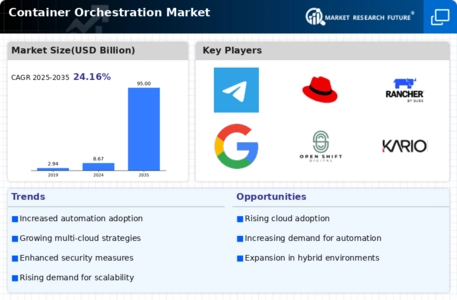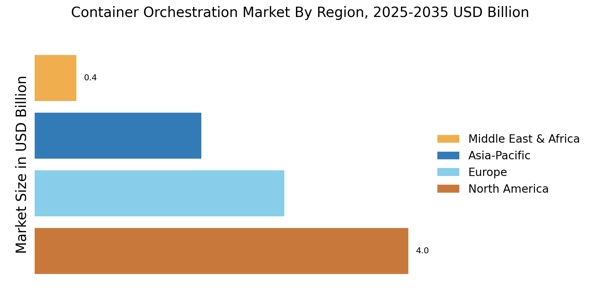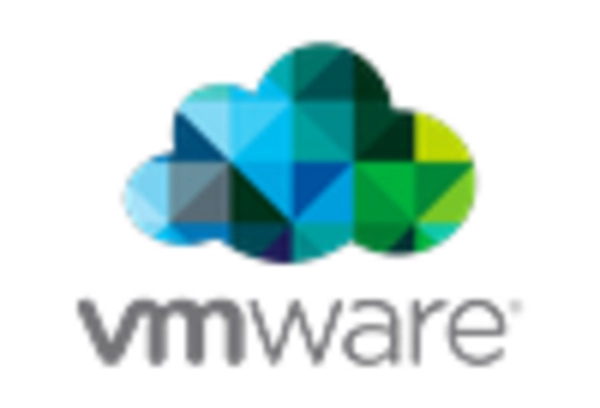Increased Adoption of DevOps Practices
The Container Orchestration Market is significantly influenced by the rising adoption of DevOps practices across various sectors. DevOps emphasizes collaboration between development and operations teams, fostering a culture of continuous integration and continuous delivery (CI/CD). This approach necessitates the use of container orchestration tools to automate deployment processes and manage containerized applications effectively. As organizations strive for faster time-to-market and improved software quality, the integration of container orchestration within DevOps pipelines becomes essential. Recent data indicates that companies implementing DevOps practices experience a 20 to 30% increase in deployment frequency, underscoring the critical role of container orchestration in achieving these objectives. Thus, the synergy between DevOps and container orchestration is likely to propel the growth of the Container Orchestration Market.
Enhanced Focus on Multi-Cloud Strategies
The Container Orchestration Market is increasingly shaped by organizations adopting multi-cloud strategies to leverage the strengths of various cloud providers. This approach allows businesses to avoid vendor lock-in and optimize their cloud expenditures. Container orchestration tools play a pivotal role in managing applications across diverse cloud environments, ensuring consistent performance and reliability. As of 2025, it is estimated that nearly 60% of enterprises are utilizing multi-cloud strategies, which necessitates sophisticated orchestration solutions to streamline operations. The ability to deploy and manage containers across multiple clouds not only enhances flexibility but also improves disaster recovery capabilities. Consequently, the emphasis on multi-cloud strategies is likely to drive further innovation and investment in the Container Orchestration Market.
Rising Need for Scalability and Flexibility
The Container Orchestration Market is witnessing a surge in demand for solutions that offer scalability and flexibility in application deployment. As businesses increasingly migrate to cloud environments, the ability to scale applications seamlessly becomes paramount. Container orchestration tools provide the necessary framework to manage containerized applications across multiple environments, ensuring that resources are allocated efficiently. In 2025, it is projected that the container orchestration market will reach a valuation of approximately 10 billion USD, driven by the need for scalable solutions that can adapt to fluctuating workloads. This trend indicates that organizations are prioritizing container orchestration as a means to enhance operational efficiency and reduce costs, thereby reinforcing its significance within the Container Orchestration Market.
Growing Demand for Microservices Architecture
The Container Orchestration Market is experiencing a notable shift towards microservices architecture, which allows organizations to develop and deploy applications as a collection of loosely coupled services. This architectural style enhances scalability and flexibility, enabling businesses to respond swiftly to changing market demands. As of 2025, it is estimated that over 70% of enterprises are adopting microservices, which in turn drives the need for robust container orchestration solutions. The ability to manage these microservices efficiently is crucial, as it can lead to improved resource utilization and reduced operational costs. Consequently, the demand for container orchestration tools that facilitate the deployment, scaling, and management of microservices is likely to continue its upward trajectory, further solidifying the position of the Container Orchestration Market.
Growing Emphasis on Automation and Efficiency
The Container Orchestration Market is experiencing a heightened focus on automation and operational efficiency. Organizations are increasingly recognizing the benefits of automating repetitive tasks associated with container management, such as deployment, scaling, and monitoring. This shift towards automation is driven by the need to reduce human error and enhance productivity. In 2025, it is projected that automation tools will account for a significant portion of the container orchestration market, as businesses seek to streamline their operations. The integration of automation within container orchestration solutions not only accelerates deployment times but also allows teams to allocate resources more effectively. As a result, the growing emphasis on automation is likely to be a key driver of growth within the Container Orchestration Market.


















Leave a Comment